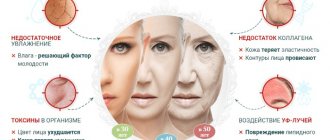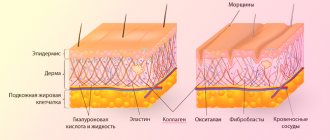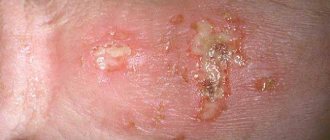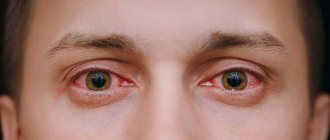What are peptides?
Peptides
- postal assistants who fight for beauty, youth and radiance of the skin. They are proteins consisting of short amino acid chains (6-7 pieces, but not more than 50), which are a building element for muscles, skin and internal organs. Peptides give the body's cells special commands and transmit important information to them. With the help of “letters”, these proteins can control biological processes in epidermal cells, turn back time, slow down aging and fight existing changes.
With age (more precisely, after 25 years), the production of natural collagen and elastin fibers (they belong to long peptides called proteins) in the skin slows down significantly. Flabbiness of the skin appears, the skin loses firmness, elasticity and turgor, wrinkles and creases appear, and tissue sagging occurs. Since no one can stop time and no one has such a superpower as not aging, we have to turn to additional anti-aging agents. Peptide cosmetics
just one of those: a modern and understandable superhero.
Peptides are small in size, so they easily penetrate into the deep layers of the epidermis,
affecting the cause of skin aging from the inside.
Depending on the form of the cosmetic product, peptides will penetrate either through cells or between them. If additional conditions are created (stimulation of hydration of the stratum corneum), deeper penetration of proteins can be achieved. Another interesting property of peptides is their ability to bind water, which makes them excellent moisturizers
that fight dryness, flaking and dehydration. This, by the way, comes as a bonus when smoothing out wrinkles, because it is known that on dry and dehydrated skin the signs of aging stand out much more strongly.
Yes, peptides are very effective, but they are also capricious. If cosmetics don’t work, it’s worth reviewing your skincare products and figuring out what you’re combining them with. Peptides lose their properties if used together with acids and retinoids. Yes, the latter also produce a pronounced rejuvenating effect, but there is no need to layer one on top of the other in order to enhance the result. Cosmetics with peptides work best in conjunction with antioxidants, moisturizing, nourishing and restorative components.
On the primacy of inflammation in acne61
In recent years, the opinion of researchers about the pathogenesis of acne has constantly changed. There is now compelling evidence that inflammation precedes an increase in the size of the sebaceous gland and the amount of sebum it produces.
Due to inflammation, the epidermal barrier is disrupted, hyperkeratosis develops, and sebum outflow becomes difficult. This leads to the formation of comedones, the formation of anaerobic conditions for increased colonization of propionibacteria.
Changes in the concept of acne have occurred due to microbiological and histological studies. They showed the appearance of neutrophils at the time of papules formation. Even with the formation of comedones in the skin, the level of CD3+ and CD4+ lymphocytes is increased, which indicate the activity of the immune system.
This enabled scientists to conclude that inflammation occurs at all stages of the formation of acne elements. If a pimple becomes inflamed, you need to make an appointment with a dermatologist.
What do peptides do?
- Restore cell renewal processes;
- Favorably influence the rate of cell division;
- Stimulate the production of collagen, elastin, hyaluronic acid and fibroblasts;
- Increases firmness, elasticity, turgor and density of the skin;
- Struggling with tissue prolapse;
- Tighten the oval of the face;
- Smooth out wrinkles and creases;
- Stimulate tissue regeneration;
- Promotes muscle relaxation;
- Stop inflammatory processes;
- Increases natural skin protection;
- Strengthen local immunity;
- Reduce tissue swelling by stimulating lymphatic drainage;
- Improves blood microcirculation;
- Strengthens the walls of blood vessels, thereby reducing the severity of rosacea and rosacea;
- Lighten pigment spots of various origins.
Copper gluconate and pyroglutamate for skin and hair
Copper in cosmetics was most often used in the form of copper salts - gluconate, copper chloride and others. Copper salts in cosmetics have an antibacterial effect and are ideal for oily skin , since copper has similar properties as silver, that is, it kills germs.
When combined with zinc and manganese in the popular active ingredient Sepitonic, copper gluconate tones and energizes the skin, awakening it, so it is recommended for use in energy drinks for the skin, which can refresh and shake it up.
There is another type of copper that is especially often used in cosmetics, this is the copper salt of pyrrolidone carboxylic acid. Copper pyroglutamate (copper PCA) has antimicrobial properties, reduces sebum secretion, moisturizes and is used primarily in cosmetics for oily skin types, alone or in combination with zinc and manganese to protect the skin from stress.
A high concentration of copper salts in a cream or gel gives cosmetics a clear, sky-blue color and aesthetic properties.
Types of peptides
Contrary to popular belief, a peptide is not one component. It is divided into several types and, depending on the name, has different effects. There are signaling, transport, neurotransmitters and enzyme inhibitors. Each of the peptides plays its own role.
Signal peptides
Signal peptides
aimed at activating the extracellular matrix and stimulating fibroblasts.
They fight skin aging. When the life cycle of a given cell is completed, the peptides give it a command, and a new cycle begins. If fibroblasts are damaged, they are restored under the influence of peptides. Signal peptides are also aimed at the production of collagen, elastin and hyaluronic acid, which are responsible for firmness, elasticity, tone and density of the skin. One of the most common signal peptides in cosmetics is Matrixyl.
Palmitoyl Tripeptide-5
and
in cosmetics .
Signal peptides are aimed at a lifting effect.
How to remove inflammation from a pimple?
There are many recipes online on how to relieve inflammation on the face from acne* the night or a couple of hours before an important event. But if such methods really existed, the work of dermatologists would be significantly easier.
If acne becomes inflamed, you should consult a doctor. It is better to do this in the early stages of acne. For mild to moderate acne, a dermatologist may recommend the use of topical azelaic acid9. These include Azelik® gel. This is an anti-acne product with the following properties5:
- normalization of keratinization processes;
- decreased levels of free fatty acids;
- manifestation of antimicrobial activity against propionibacteria and epidermal staphylococcus;
- anti-inflammatory effect, which can be explained by the ability to reduce the metabolism of neutrophils and the free radical forms of oxygen they produce.
The importance of contacting a dermatologist is not only that he will recommend how to remove inflammation from a pimple, but will also be able to identify the cause of acne and, if necessary, refer you for a consultation with another specialist (endocrinologist, gynecologist, etc.). Sometimes a specialist prescribes not one drug, but a combination of drugs. Thus, to enhance the effect of Azelik® gel, it can be combined with the topical antibiotic clindamycin (for example, Clindovit® gel)22.
The use of cosmetic products with peptides for face and body care
Peptide cosmetics appeared in the 70s, when scientists found a way to store peptides for a long time. The method of their “preservation” was invented by the Swiss doctor Warburg ,
having confirmed their hypotheses with experiments, after which it became possible to produce peptide cosmetics, which subsequently gained great popularity throughout the world. Gradually, the market was replenished with drugs for injection procedures.
In this article we will look at two main areas of using drugs with peptides in cosmetology:
Cosmetic skin care products that can be used in cosmetology programs, both manual and using hardware techniques.
Injection techniques: mesotherapy, biorevitalization, contouring (fillers).
Table 1. Individual properties of peptides used in modern cosmetology
| Name (commercial/scientific) | Properties |
| Stimulants | |
| Matrixy (palmitoyl pentapeptide-3) |
|
| Dermaxyl, Biopeptide EL (palmitoyl oligopeptide) |
|
| Biopeptide CL, Trylagen, Aldenine (palmitoyl tripeptide-1) |
|
| Syniorage (acetyl tetrapeptide-11) |
|
| Dermican (acetyl tetrapeptide-9) |
|
| Lipospondin (elaidyl tripeptide) |
|
| Syn-Coll (palmitoyl tripeptide-5) |
|
| Decorin (tripeptide-10 citrulline) |
|
| ChroNoLine (caproyl tetrapeptide-3) |
|
| Serilesine (hexapeptide-10) |
|
| Blockers | |
| Argireline (acetyl hexapeptide-3) |
|
| SNAP-7 (acetyl glutamyl hectapeptide-1) |
|
| SNAP-8 (acetyl octapeptide-3) |
|
| Leuphasy (pentapeptide-18) |
|
| Syn-Ake (diaminobutyrene benzylamide diacetate dipeptide) |
|
| Vialox (pentapeptide-3) |
|
| Inyline (acetyl hexapeptide-25) |
|
| Stabilizers | |
| Aldenine, Kollaren (tripeptide-1) |
|
| Prezatide Copper Acetate (copper peptide) |
|
| Peptamide-6 (hexapeptide-11) |
|
| Preventhelia (diaminopropionoyl tripeptide-33) |
|
| Regulators of melanogenesis | |
| Melanostatine (nonapeptide-1) |
|
| Melatime (palmitoyl tripeptide-30) |
|
| Melitane (acetyl hexapeptide-1) |
|
| Immunomodulators | |
| Palmitoyltetrapeptide-3 |
|
| Rigin (palmitoyl tetrapeptide-7) |
|
| Bodyfensine (acetyl dipeptide-3 aminohexanoate) |
|
| Thymulen-4 (acetyl tetrapeptide-2) |
|










